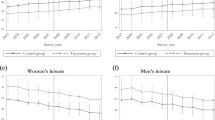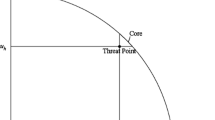Abstract
This paper analyzes the labor market participation behavior of retiring couples in Norway. To account for the unobserved heterogeneity in decision-making structure within the household, I formulate a mixed model by assuming there are two types of households, the cooperative type and the non-cooperative type. I assume that non-cooperative households behave according to a Stackelberg game with the male as the leader, while cooperative households engage in a cooperative bargaining process. The estimation results show that more than half of the households are of the non-cooperative type.
Similar content being viewed by others
References
Patricia Apps Rees Ray (1988) ArticleTitle“Taxation and the Household” Journal of Public Economics 35 355–369 Occurrence Handle10.1016/0047-2727(88)90037-0
Gary Becker (1973) ArticleTitle“A Theory of Marriage: Part I” Journal of Political Economy 81 813–846 Occurrence Handle10.1086/260084
Gary Becker (1974) ArticleTitle“A Theory of Marriage: Part II” Journal of Political Economy 82 511–526
Ted Bergstrom (1997) “A Survey of Theories of the Family” Stark Oded Rosenzweig Mark (Eds) Handbook of Population and Family Economics Elsevier New York 21–79
M. Blau David (1997) ArticleTitle“Social Security and the Labor Supply of Older Married Couple” Labor Economics 6 229–251
Richard Blundell MaCurdy Thomas (1999) “Labor Supply: A Review of Alternative Approaches” Ashenfelter Orley Card David (Eds) Handbook of Labor Economics 3A Elsevier Science Amsterdam 1560–1695
Martin Browning Chiappori Pierre-André (1998) ArticleTitle“Efficient Intra-Household Allocations: A General Characterisation and Empirical Tests” Econometrica 66 IssueID6 1241–1278
Gary Burtless (1990) “Comment: The Joint Retirement Decision of Husbands and Wives” Wise David (Eds) Issues in the Economics of Aging The University of Chicago Press Chicago 255–257
Zhiqi Chen Woolley Frances (2001) ArticleTitle“A Cournot-Nash Model of Family Decision Making ” Economic Journal 111 722–748 Occurrence Handle10.1111/1468-0297.00657
Pierre-André Chiappori (1988) ArticleTitle“Rational Household Labor Supply” Econometrica 59 925–951
Pierre-André Chiappori (1992) ArticleTitle“Collective Labor Supply and Welfare” Journal of Political Economy 100 437–467 Occurrence Handle10.1086/261825
Dagsvik John K., Steinar Strøm. (2004). “Sectoral Labor Supply, Choice Restrictions and Functional Form”. Journal of Applied Econometrics,. forthcoming
Authur P Dempster Laird Nan M Rubin Donald B (1977) ArticleTitle“Maximum Likelihood from Incomplete Data via the EM Algorithm” Journal of the Royal Statistical Society Series B 39 IssueID1 1–38
Stefan Dercon Krishnan Pramila (2000) ArticleTitle“In Sickness and in Health: Risk-sharing within Households in Rural Ethiopia” Journal of Political Economy 108 688–727 Occurrence Handle10.1086/316098
Yuk-fai Fong Zhang Junsen (2001) ArticleTitle“The Identification of Unobservable Independent and Spousal Leisure” Journal of Political Economy 109 IssueID1 191–202 Occurrence Handle10.1086/318599
A. Godoy Ricardo (2002) ArticleTitle“The Life Cycle, Ecological, and Economic Determinants of Spousal Leisure Sharing: Panel Estimations From Tawahka Amerindians, Honduras” Human Ecology 30 IssueID3 317–337 Occurrence Handle10.1023/A:1016568518628
Shoshana Grossbard (2004) “Becker’s Intellectual Leadership in the Theory of Marriage” San Diego State University Manuscript
L. Gustman Alan Steinmeier Thomas L. (2000) ArticleTitle“Retirement in Dual-Career Families: A Structure Model” Journal of Labor Economics 18 IssueID3 503–545 Occurrence Handle10.1086/209968
James Heckman Singer Burton (1984) ArticleTitle“A Method for Minimizing the Impact of Distributional Assumptions in Econometric Models for Duration Data ” Econometrica 52 IssueID2 271–320
Hernæs Erik., Zhiyang Jia., Steinar Strøm. (2001). “Retirement in Non-Cooperative and Cooperative Families”. CESifo working paper No 476
Bridget Hiedeman (1998) ArticleTitle“A Stackelberg Model of Social Security Acceptance Decisions in Dual-career Households” Journal of Economic Behavior and Organization 34 263–78 Occurrence Handle10.1016/S0167-2681(97)00058-9
Michael D Hurd (1997) “The Joint Retirement Decisions of Husbands and Wives” Wise David A (Eds) Issues in the Economics of Aging University of Chicago Press Chicago 231–254
Jia Zhiyang. (2000). “Family Labor Supply when the Husband is Eligible for Early Retirement: Some Empirical Evidence.” Memorandum from Department of Economics, University of Oslo, No 04/2000
Jia Zhiyang. (2005). “Retirement Behavior of Working Couples in Norway, A Dynamic Programming Approach.” Discussion papers 405, Research Department, Statistics Norway
A. Kamakura Wagner Russell Gary J (1989) ArticleTitle“A Probabilistic Choice Model for Market Segmentation and Elasticity Structure” Journal of Marketing Research 26 379–390
A. Konrad Kai Lommerud Kjell E (1995) ArticleTitle“Family Policy with Non-Cooperative Families” Scandinavian Journal of Economics 97 581–601
Peter Kooreman (1994) ArticleTitle“Estimation of Econometric Models of Some Discrete Games” Journal of Applied Econometrics 9 255–68
Shelly Lundberg Pollak Robert A (1994) ArticleTitle“Noncooperative Bargaining Models of Marriage” American Economic Review 84 IssueID2 132–137
Nicole Maestas (2001) “Labor Love and Leisure: Complementarity and the Timing of Retirement by Working Couples” Department of Economics, UC Berkeley Manuscript
Marilyn Manser Brown Murray (1980) ArticleTitle“Marriage and Household Decision Making: a Bargaining Analysis” International Economic Review 21 IssueID1 31–44
F. Manski Charles (1977) ArticleTitle“The Structure of Random Utility Models” Theory and Decision 8 229–254 Occurrence Handle10.1007/BF00133443
Mauro Mastrogiacomo Alessie Rob Lindeboom Maarten (2004) ArticleTitle“Retirement Behavior of Dutch Elderly Households” Journal of Applied Econometrics 19 777–793 Occurrence Handle10.1002/jae.784
L. McCutcheon Allan (1987) Latent Class Analysis, Sage University Paper Series: Quantitative Applications in the Social science, 07-064 Sage Publications Beverly Hills
B. McElroy Marjorie Horney Mary J (1981) ArticleTitle“Nash Bargained Household Decisions” International Economic Review 22 IssueID2 333–350
Daniel L. McFadden (1974) “Conditional Logit Analysis of Qualitative Choice Behavior” Zarembka Paul (Eds) Frontiers of Econometrics Academic Press New York 105–142
Paul Samuelson (1956) ArticleTitle“Social Indifference Curves” Quarterly Journal of Economics 70 1–22
Chris Udry (1996) ArticleTitle“Gender, Agricultural Production, and the Theory of the Household” Journal of Political Economy 104 1010–1046 Occurrence Handle10.1086/262050
Soest ParticleVan Arthur Das Marcel Gong Xiaodong (2002) ArticleTitle“A Structural Labor Supply Model with Flexible Preferences” Journal of Econometrics 107 345–374 Occurrence Handle10.1016/S0304-4076(01)00128-2
Frederic Vermeulen (2002) ArticleTitle“Collective Household Models: Principles and Main Results” Journal of Economic Surveys 16 IssueID4 533–564 Occurrence Handle10.1111/1467-6419.00177
J. Yakowitz Sidney Spragins John D. (1968) “On the Identifiability of Finite Mixtures” Annuals of Mathematical Statistics. 39 209–214
Author information
Authors and Affiliations
Corresponding author
Additional information
*Part of this paper was written while I was working at Department of Economics, University of Oslo and the Ragnar Frisch Center for Economic Research. I would like to thank Eivind Bernhardsen, John K. Dagsvik, Erik Hernæs and Steinar Strøm for their insightful comments. I am grateful to two anonymous referees and the editor, Professor Shoshana Grossbard, for providing valuable comments that greatly improve this paper. Financial support from the Research Council of Norway (project 140082/530) is gratefully acknowledged. The usual disclaimer applies.
Rights and permissions
About this article
Cite this article
Jia, Z. Labor Supply of Retiring Couples and Heterogeneity in Household Decision-Making Structure. Rev Econ Household 3, 215–233 (2005). https://doi.org/10.1007/s11150-005-0711-3
Received:
Accepted:
Issue Date:
DOI: https://doi.org/10.1007/s11150-005-0711-3




